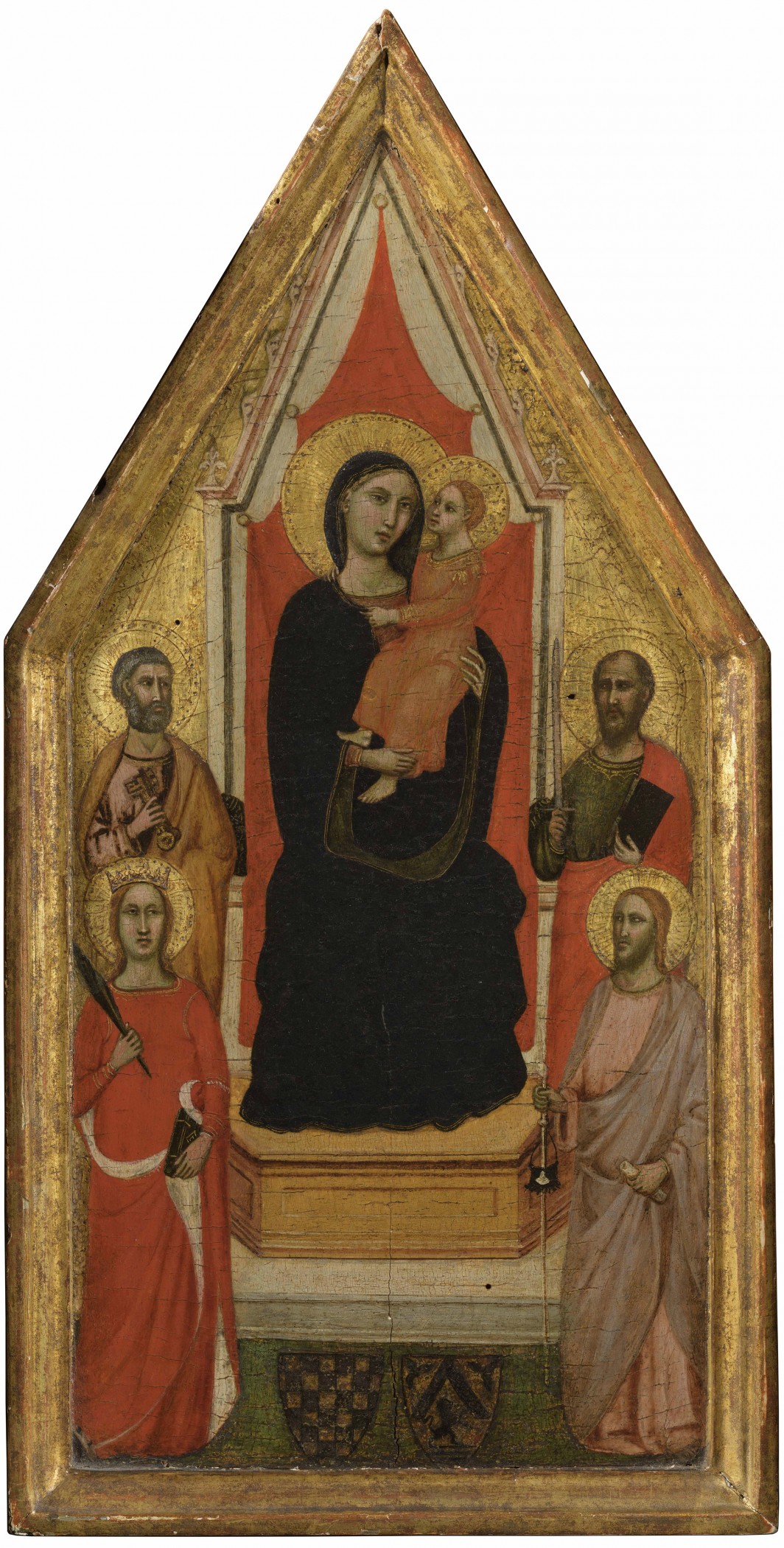Pacino di Buonaguida
(Florence c. 1280 - 1348 Florence)
Madonna and Child Enthroned c. 1320
tempera on panel, 45 x 23 cm (17.72 x 9.06 inches)
Pacino di Buonaguida
(Florence c. 1280 - 1348 Florence)
Madonna and Child Enthroned c. 1320
tempera on panel, 45 x 23 cm (17.72 x 9.06 inches)
Re: 850
Provenance: Private collection
M. Boskovits, The Fourteenth Century. The Painters of the Miniaturist Tendency, Firenze,
1984, p. 265, ill. Pl. CIX
The Virgin is seated on a high throne, decorated with a red canopy, she gently holds the Child, who for his part encircles her neck with his right arm and lightly pulls her cloak with his other hand. On either side of the sacred group are, on the left, St. Peter with the attribute of the keys and a martyr with a crown and book - perhaps identifiable as St. Catherine of Alexandria, although the usual cogwheel to identify her is missing -, while on the right are St. Paul, with a sword, and St. James the Greater, with a pilgrim's staff and the Gospel scroll illustrating his apostolic mission.
The panel was studied by Miklós Boskovits, who, in the first volume of the Corpus of Florentine painting he edited, included it in the catalogue of paintings by the Florentine artist Pacino di Buonaguida[1]. This master was best known for his dense activity as an illuminator, an activity that nevertheless saw him at the head of an important workshop, within which several autonomous personalities have been identified by modern critics[2]. His profile as a painter is much more elusive: his only signed painting is the polyptych with the Crucifixion among the Sorrowful and Saints Nicholas, Bartholomew, Fiorenzo and Luke, formerly on the high altar of the church of San Firenze and now in the Gallerie dell’Accademia[3]. On the basis of this painting, Richard Offner[4]beforehand and then Boskovits attempted a coherent reconstruction of Pacino's career, which, according to the documents, spanned a wide period of time: from 1303 - the year in which he is mentioned in a notarial deed for the end of his professional relationship with another unknown painter, a certain Tambo di Serraglio, a sign nonetheless that at the beginning of the century his activity had already begun[5] - to almost the middle of the century. It is likely that his training in Florence anticipated the clear influence of Giotto that he later underwent. Boskovits, in the wake of Offner's assertions, places Pacino in the group of masters of the 'miniaturist tendency', painters who were certainly not impermeable to Giotto's suggestions of perspective, but also witnesses of a moody and expressionist art that showed links above all with the character of transalpine Gothic. With regard to our painting, the Hungarian historian - who recalled in 1984 that he had only studied it through a photograph, and of which he was therefore unaware at the time even of its location - complained about the presence of scaling on both sides, as well as restorations that had been carried out on the figures of the Virgin and Child. Boskovits was of a different opinion in a letter of May 2002, when he had the opportunity to analyse the painting through high-resolution photographs: here he attests to the good condition of the panel, perhaps slightly reduced at the top by the presence of the projecting frame[6], but otherwise intact in all its parts.
The two coats of arms at the foot of the throne are of particular interest: the one on the left is certainly referable to the Barbadori family, a lineage that had already attained a notable position of prestige in Florence in the early 14th century. It is more difficult to identify the one on the right, with a rampant lion, and which does not appear in the database of the Florentine Stemmario, compiled by the library of the Kunsthistorisches Institut. As for Pacino's entire painting activity, it is even difficult to propose a certain date for our panel. A point of contact can certainly be found with the central panel of the portable altarpiece formerly in the Marchi collection and now in the Uffizi Gallery (Madonna and Child Enthroned between Two Martyred Saints and Saints Peter and Paul, inv. 1890 no. 9806), this early work, possibly dating from the beginning of the second decade of the century[7]. However, the figures of the four saints betray impressions of Giotto's Florentine works, perhaps presupposing Pacino's achievement of formal maturity. A date of 1320, in close proximity to the polyptych of San Firenze, therefore seems the most likely.
[1] M. Boskovits, A critical and historical corpus of Florentine painting, III, 9, The fourteenth century. The painters of the miniaturist tendency, Florence 1984, p. 265, pl. CIXa
[2] The bibliography concerning Pacino di Buonaguida's activity as an illuminator is obviously very dense. For a general reference we refer to A. Labriola, Pacino di Buonaguida entry, in Dizionario biografico dei miniatori italiani. Secoli IX-XVI, edited by M. Bollati, Milan 2004, pp. 841-843 and especially F. Pasut, Pacino di Buonaguida miniatore. Studi sullo sviluppo artistico e un catalogo ragionato, PHD dissertation in History of Art (18th cycle), supervisor prof. Miklós Boskovits, University of Florence, 2006
[3] A. Tartuferi, in Galleria dell'Accademia di Firenze. Dipinti, I, Dal Duecento a Giovanni da Milano, edited by M. Boskovits and A. Tartuferi, Florence 2003, pp. 206-210, no. 39; F. Pasut, in Florence at the dawn of the Renaissance. Painting and illumination 1300-1350, edited by C. Sciacca, exhibition catalogue (Los Angeles, The J. Paul Getty Museum, 13 November 2012 - 10 February 2013), Los Angeles 2012, pp. 104-107, no. 21
[4] Tra i contributi di Offner si menziona qui il primo: R. Offner, Pacino di Buonaguida, a contemporary of Giotto, in “Art in America”, XI, 1922, 1, pp. 3-27. Lo storico tornerà in seguito più volte sul pittore, per definirne il catalogo dell’attività

